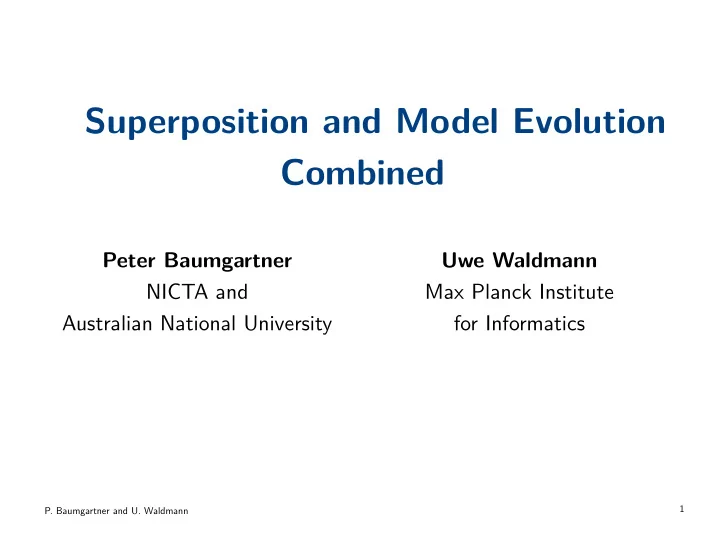

Superposition and Model Evolution Combined Peter Baumgartner Uwe Waldmann NICTA and Max Planck Institute Australian National University for Informatics 1 P. Baumgartner and U. Waldmann
Motivation • Both Superposition and Model Evolution are calculi for FOL = • Superposition – Equality, redundancy elimination – Decides Guarded Fragment, Monadic class, ... – Wins FOF CASC division • Model Evolution, more generally "Instance Based Methods" – Conceptually different to resolution/superposition – Method of choice for Bernays-Schönfinkel class (EPR) – Wins EPR CASC division Combine Superposition and Instance Based Methods? ME+Sup = Model Evolution + Superposition P. Baumgartner and U. Waldmann 2
Motivating Example Ordered arrays • Termination on (1)-(3): ME: yes Superposition: no • Termination on (4)-(6): ME: no Superposition: yes • Termination on (1)-(6): ME+Sup: yes - use ME for ≤ -literals - use Superposition for ≈ -literals P. Baumgartner and U. Waldmann 3
Propositional Resolution → Superposition Ordered resolution Superposition - ground level P. Baumgartner and U. Waldmann 4
Propositional Resolution → Superposition Ordered resolution Superposition P. Baumgartner and U. Waldmann 5
DPLL → Model Evolution (ME) DPLL ME no - Split - Branches a re called "contexts" - Context induces interpretation - Split to repair interpretation Close - Close to abandon interpretation Induced Interpretation via Productivity P. Baumgartner and U. Waldmann 6
Productivity A context literal K ∈ Λ produces L iff (i) L is an instance of K and (ii) there is no more speci fi c literal in Λ that produces L produces A "syntactic" notion! Not an E-Interpretation Productivity is a central concept in the combination of ME and superposition via constrained clauses P. Baumgartner and U. Waldmann 7
ME+Sup - Constrained Clauses C is evaluated "semantically", Γ is evaluated "syntactically" P. Baumgartner and U. Waldmann 8
ME+Sup - Constrained Clauses C is evaluated "semantically", Γ is evaluated "syntactically" P. Baumgartner and U. Waldmann 9
ME+Sup - Constrained Clauses C is evaluated "semantically", Γ is evaluated "syntactically" P. Baumgartner and U. Waldmann 10
ME+Sup - Constrained Clauses C is evaluated "semantically", Γ is evaluated "syntactically" P. Baumgartner and U. Waldmann 11
ME+Sup Calculus - Initialisation • Given : clause set M • Initialisation – Context ¬ x – Constrained clause set Φ = { C ⋅∅ | C ∈ M } It holds Λ, I ⊨ Φ iff I ⊨ M • User-supplied control parameters – Term ordering, as usual – Labelling on ground atoms: split atoms ∪ superposition atoms = Herbrand base – Can also con fi gure pure ME or pure Superposition calculus: superposition atoms = ∅ or split atoms = ∅ P. Baumgartner and U. Waldmann 12
Labelling Example split / superposition atom Labelling is used to control inference rule applications P. Baumgartner and U. Waldmann 13
ME+Sup Calculus - Inference Rules Clause (x Clause) ↦ Clause Context x Clause ↦ Clause Context x Clause ↦ Context x Context split / superposition atom P. Baumgartner and U. Waldmann 14
U-Sup: Context x Clause ↦ Clause P. Baumgartner and U. Waldmann 15
U-Sup: Context x Clause ↦ Clause At least one ground instance is a split atom P. Baumgartner and U. Waldmann 16
Sup: Clause x Clause ↦ Clause Standard Superposition is a special case P. Baumgartner and U. Waldmann 17
Split: Context x Clause ↦ Context x Context P. Baumgartner and U. Waldmann 18
Derivation Example (No equality in this example, empty constraints not shown) leq-atoms: split ≤ -atoms: superposition leq-atoms ≻ ≤ -atoms Initial context is ¬x Resolution on (1a) and (1b) is blocked P. Baumgartner and U. Waldmann 19
Derivation Example (Split) (ctxt-1) (Derivation continues, but will terminate eventually) Inference rule applications controlled by labelling, orderings, productivity, redundancy/simplification P. Baumgartner and U. Waldmann 20
Redundancy and Simpli fi cation • A ground clause C ⋅ Γ is redundant if it follows from smaller ground clauses and "certain additional conditions" are satis fi ed • DPLL-style simpli fi cation rules by elements from current context Λ f ( x ) ≈ x ⋅ g ( a ) ≈ a f ( x ) ≈ x ⋅ g ( a ) ≈ a if g ( a ) ≈ a ∈ Λ if g ( a ) ≉ a ∈ Λ • Simpli fi cation by clauses from current clause set Φ f ( x ) ≈ h(x) ⋅ g ( x ) ≈ x f ( x ) ≈ x . g ( x ) ≈ x ∈ Φ x ≈ h(x) ⋅ g ( x ) ≈ x, g ( x ) ≈ x Generalizes redundancy/simpli fi cation of ME and Superposition P. Baumgartner and U. Waldmann 21
Soundness and Completeness • ME+Sup is sound • ME+Sup (with simpli fi cation) is refutationally complete – Every fair derivation from an unsatis fi able clause set ends in a derivation tree where every leaf is closed – Fairness: every inference from persistent non-redundant premises becomes redundant eventually – But input clauses must not contain constraints P ( x ) ⋅∅ is OK □ ⋅ ¬ P ( x ) is not OK – Proof by adaptation of Bachmair/Ganzinger model construction technique P. Baumgartner and U. Waldmann 22
Model Construction P. Baumgartner and U. Waldmann 23
Conclusions • ME+Sup – Properly generalizes Superposition with redundancy criteria – Generalize essentials of Model Evolution with Equality (universal variables and some optional inference rules missing) – Symmetric integration, con fi guration of mixed calculi • Technical complications required some new concepts • Future work – New decision procedures? – Generalization of full Model Evolution with Equality – "Basic" variants of inference rules P. Baumgartner and U. Waldmann 24
Recommend
More recommend